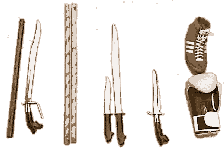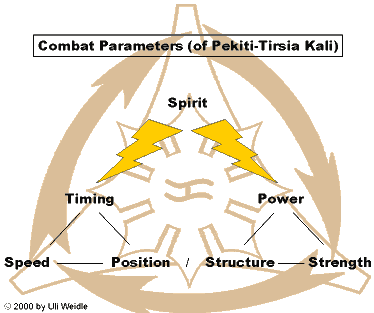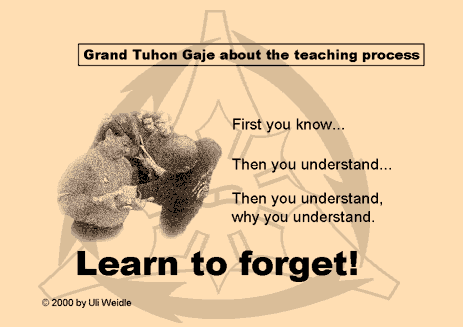Round about the knife
A central element of the Pekiti Tirsia System is training with and against the knife. A purposeful knife training, as it is represented in our Kali training system, combines and develops all qualities needed by a skillful fighter: physical fitness, decision making power, determination, courage, self-confidence, understanding the necessity for and the ability to maintain "Situational Awareness" and a strategic-tactical approach.
Not only Pekiti Tirsia recognised the importance of the knife: other Filipino Martial Arts systems and combat systems of other cultures recognised this too. For example Col. Rex Applegate considered a knife as the 'Confidence-Builder' – he recommended OSS agents to always carry a knife (or an unsuspicious every day item, that if needed can be used like a knife).
Knife training is a crucial part of Pekiti Tirsia. If ever it would be possible to reduce the Pekiti Tirsia system to only one weapon category without loosing essence, then this one category must be the knife. Yet, knife training by itself is not complete. For optimal results it needs more then that...
Optimal training results using weapons, that focus on specific training targets

The performance of a fighter is determined by various qualities or attributes, that can be specifically trained. Like a well trained fitness coach is able to quickly locate the physical strength and weaknesses of an athlete and then recommends specific exercises using appropriate equipment, so does an experienced martial arts teacher quickly recognize and understand
the individual strengths and shortcomings of a person, and based on that, he knows what training methods will produce best results for that person.
To allow for that type of optimised training procedures to start as early as in basic training, the Pekiti Tirsia Europe training system complements the variety of available body exercises from the very beginning with a complete set of specific and functional training devices:
The five weapon categories of Kali basic training
-
Solo Weapon: Sticks and Swords of various length and weight. Typical for basic training is the arms length "Kali-Stick" as Impact-Weapon or the same length filipino short sword (Edged Weapon). The Malayu Sibat (long pole, spear) too is an important part of this category.
-
Symmetric Double Weapon: Double Stick, Double Sword
-
Long– and short weapon: Sword and knife also known as Espada y Daga, Stick and knife
-
Body Weapons: Hands, Forearm, Elbow, Shoulder, Knee, Shin, Foot,... (for further reading, see our Article: Open Hands of Pekiti Tirsia)
-
Knife
Our training system uses sticks, swords and knifes of different length, weight and shape, so that the practitioner develops an intuitive understanding for variety of weapons and movements. This understanding of variety is as a general principle also applied for example for clothes. Tight clothes or heavy boots for example can drastically alter the dynamics of executing kicks.
Around the Knife
It is because of its importance for our training system, that the knife is listed as a separate category. As double knifes (one knife in each hand) or single knife (according to our understanding there is no such thing as «single knife» but rather: «knife and hand»; the empty hand is not idle but supports and assists the knife in every action) it combines and integrates the characteristics of the other four named categories. Indeed it is such, that each of the other four categories is emphasizing and

detailing a different crucial aspect of fighting with or against knife. That is the reason why those five weapon categories establish the functional core of our foundation system: Used as a functional framework extending the core field of knife combat, the weapon categories 1) to 4) are perfectly enhancing practical knife training.
If the five weapon categories are used as a complete system, then they not only allow for, but almost guarantee that the methods and strategies of self-defence and close combat are trained and understood thoroughly, with true consideration of all meaningful variables relevant for success and survival.
"SPEAR and STPAP"
or: What must be trained?
The Pekiti Tirsia heir and keeper Grand Tuhon Leo T. Gaje collects the essential five physical qualities of a fighter with the Acronym "STPAP": Speed, Timing, Power, Accuracy (proper force, balance) and Precision.
These and other physical attributes are
based on the non-physical human qualities
Spirit & Heart: decision making power, self-leadership, courage, compassion, commitment and self-confidence.

In a real world situation – may it be a physical confrontation or a different kind of emergency – those mental qualities make the difference in how well the available physical resources can be put into effective use. All in all Spirit & Heart are providing the solid ground, which allows for the development and manifestation of the persons physical skills.
"The SPEAR composed from spirit & heart transforms to STPAP" — that is an important result distilled from the timeless experience of generations of trainers. With the importance of physical and mental development well understood, Kali is a training system that works holistic with the complete human being, helping the practitioners to improve the desired physical skills harmonically supported by a personality matured in Spirit and Heart.
Complete & Accelerated, because »good« is not good enough!
A complete training system develops the practitioners in all crucial qualities; in technical skill and physical attributes same as in the quality of spirit and heart.
Knife oriented training accelerates that process: Considering the special dynamics, danger and brutality of a knife fight, it is obvious that all essential qualities of a fighter are indeed required in a sharpness, as it is otherwise rarely known. In a confrontation with a knife, »good« is not good enough. Because of this a serious knife system prepares the trainee as intensive and fast as possible in all qualities that are needed for a successful fighter. This is the deeper reason (more important as tradition or cultural reasons) why knife training is central in the Pekiti Tirsia system: Knife training is the ideal learning accelerator.
Well trained Kali trainers not only know about the advantages of knife training but also about the pitfalls pure knife training can hold for a fighter. As is for example the among "technicians" (used in contrast to "practitioners") popular tendency to trust and rely on the sharpness of the blade. Influenced by eye catching commercially available knife videos, the technicians among the FMA and knife fighting community adopted in recent years the belief in the 'One-Cut Kill', that is often propagated with the hope in 'Instant-Shock'. A dangerous belief, that, even more so than the belief in the 'One Punch Kill' as known from diverse budo arts, can be a deadly error.
Here is a crucial difference between a "Showman" (a technical impressive knife "artist") and a really highly effective knife fighter: The later is a practician, who uses the knife without any fantasies like a tool for success and survival. He knows about the difference between killing and stopping as well as between hurting and surviving. A trained fighter with wisdom, heart and ratio – in Kali we consider such a person a "warrior".
Knife Culture – Experience and Tradition
Since our Kali system has been and still is continuously tested in real close quarter combat situations (see for example our article "Pekiti Tirsia and the Military") the danger resulting from the 'One-Cut Kill'–idea is well understood. Because of this, one of the most important lectures taught to beginners is for them to get aware of the difference between hurting, killing, stopping and surviving, and to really comprehend what that means. They experience the life-appreciating knife culture of the old Filipino, which is in total contrast to the life destroying Fast-Food knife training, that is so often propagated in the context of sports competition. A "fair" reglemented duel fight, maybe to the first blood, in every regard is different from a serious be or not to be situation.

Passing along the knife culture follows the same truth, that is always there, when practical skill is the measure of success: experience beats knowledge.
If the balance of the knife culture is to be experienced, then it must be experienced live, as an immanent part of practical training.
If ever the training becomes one sided, the training will be learned knowledge only and it will never be the real habit forming experience, that it should be.
As Pekiti Tirsia Grand Tuhon used to say: "First you know, then you understand."
The trainees have to first collect experience
– and literally to feel it – before they are able to really understand. Therefore experienced Pekiti Tirsia trainers prefer to balance the sharpness of the blade by training with
impact weapons: stick and body weapons.
Only the proper combination of practice

methods can make sure, that the proper balance of the result is achieved. Or in the words of Grand Tuhon: "The secret is not the technique, but how the technique is given to the student."
Specific effects of weapon training: The total is more then the sum of it's parts

Like body weapon or stick training connect to knife training in such a way, that they enhance the quality of the knife training results, so do all weapon categories of Kali create an interwoven system of mutual support: In its entirety it becomes more then merely the sum of all its components.
Crucial for the synergism effect to kick in is, that the weapon categories are not trained as a random mixture or mere collection of techniques, but in a way, that re-uses equal or similar patterns of movement, power generating methods and action principles across all methods.
This multiple usage is not only practical for training, it is also a necessity for being able to handle real life situations. Because as a matter of fact, the transition between impact (stick) and
edged weapon are smooth. A stick might have sharp edges (the in-famous 4 by 4, the flat-stick) and a knife may be used with negligence of its cutting power as a blunt weapon (closed folder). When utilising a telescopic stick the length of the weapon might change during the actual fight. If training shall enable a fighter to handle the variety of possible real life situations, then the training should actually prepare him for that.
Here an overview about the weapon categories of our core system and what qualities they primarily produce.
-
single stick / single weapon: focus, power generation, distance control, timing.
-
symmetrical double weapon: symmetry, adaptability and spontaneity, courage, co-ordination and precision.
-
long– and short weapon (Espada y Daga): secondary Awareness, moving between and connecting distances, preparation.
-
knife: survivor attitude, explosivity, pre-fight problem solving (PFPS), tactical positioning in close range, awareness, respect.
-
body weapons: self-confidence, independence
This five weapon categories establish a compact and as well comprehensive practice system, that is holistic as described previously. The techniques and methods of our core system are chosen such, that the multiple usage and transfer of concepts, pattern of power generation and movement is easily accomplished. One method of training or weapon category supports and improves the other. They act as a system in harmonious union.
Beyond this core of the system there are further weapon categories, which can be taught independently as encapsulated modules or as supplements of the core system. These modules offer for example the possibility for the specialization in different kinds of swords, palm stick, long pole/spear (Sibat), telescope stick, shield, flexible weapons and modern weapons as for example handcuffs, spray weapons, pistols, rifles, entrenching tools, electro-shockers or practical combinations of long and short weapons, like e.g. light and knife, pepper spray and baton, handcuff and telescope stick...
The sophistication of the our training system shows in the fact, that a person who gained sufficient experience in the core system, is in shortest time able to adapt to new situations and handle any of the weapons specified above with efficiency.
The true value of the core system can be observed when persons during the trainig process not only develop the physical ability for self-protection, but also a positive mindset and in the consequence: confidence, initiative and self-assurance.
Conclusion

A self-protection art must prepare for the variety of probable threats. A life art is to support the qualities, which are helpful for success and health in the life. Pekiti Tirsia is both: self-protection art and life art. Risk consciousness, self-assurance, confidence and caution must be held in proper balance. This is the task of the Pekiti Tirsia trainer. His most important tools are the five weapon categories of the Pekiti Tirsia.
Author: Uli Weidle
Manila, 31 July 2004
Copyright and Publishing Information
The above article has been first published in July 2004 on the Pekiti Tirsia Europe web-site (www.pekiti-tirsia.net). The article is copyrighted © 2004 by the author Uli Weidle.
Quoting and linking to this article for non-commercial purposes is allowed, if a link to the web-site www.armadong.com is provided.
The author can be reached: uli@armadong.com
After the web-site www.pekiti-tirsia.de went offline the article was republished in June 2019 on www.armadong.com.
